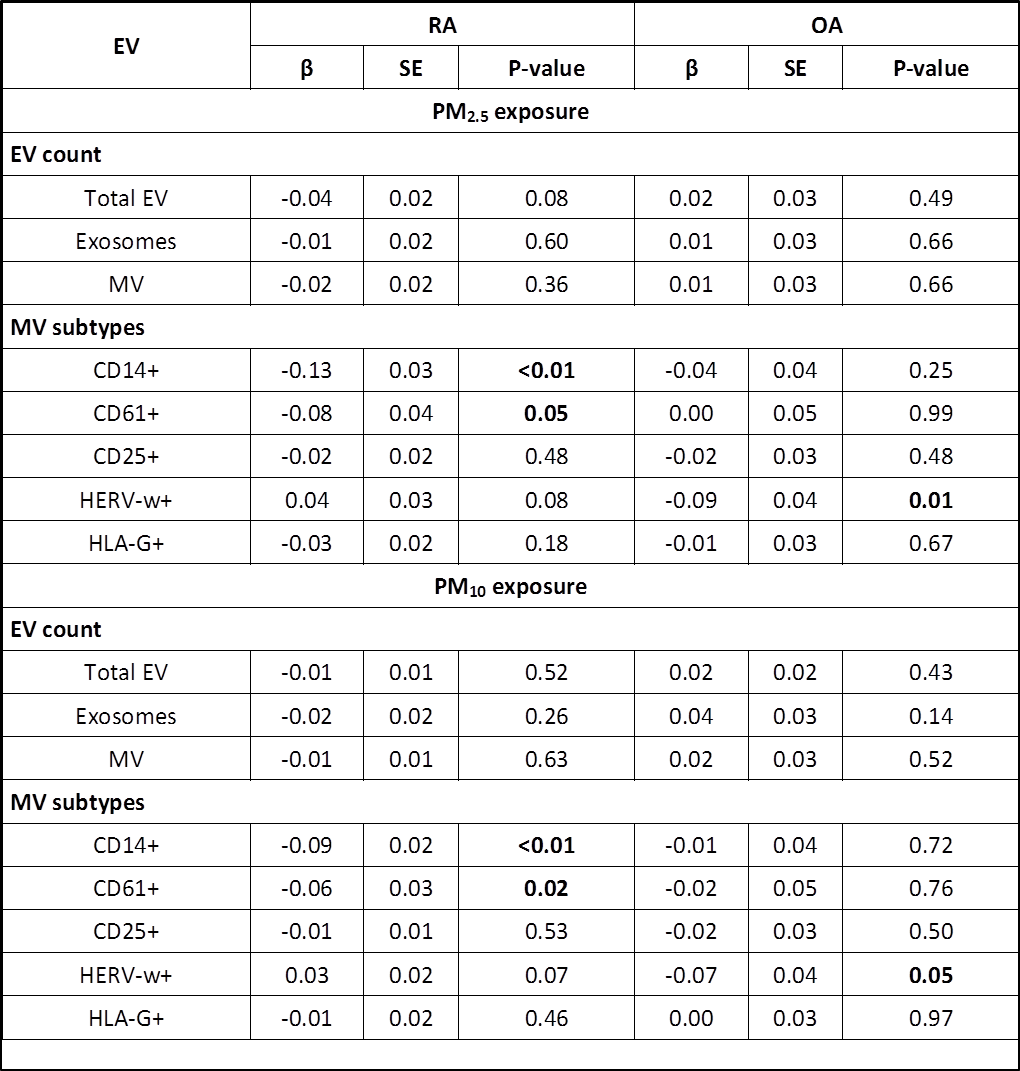Session Information
Session Type: Poster Session (Sunday)
Session Time: 9:00AM-11:00AM
Background/Purpose: Rheumatoid arthritis (RA) is an heterogeneous chronic autoimmune disorder potentially leading to a progressive joint damage with great impact on quality of life. RA pathogenesis is complex and involves environmental factors that trigger disease in genetically susceptible individuals. Extracellular vesicles (EVs) have been described to play an important role in RA pathogenesis and to modulate autoimmune response following environmental exposures, such as air pollution.
Our aim was to evaluate the effects of particulate matter (PM) with aerodynamic diameter ≤ 10 μm (PM10) and ≤ 2.5 μm (PM2.5) on EVs in RA and osteoarthritis (OA) as control.
Methods: Plasma EVs were analyzed by Nanosight and flow cytometry: CD14 (monocyte/macrophage), CD61 (platelet), CD25 (T-reg), human endogenous retrovirus w (HERV-w), human leukocyte antigen G (HLAG). Demographic and clinical data were collected for each patient. Plasma EV concentrations were measured in RA and OA patients and were analyzed by generalized linear regression models. Daily PM concentrations, estimated by Regional Environmental Protection Agency at municipality resolution, were used to assign short-term exposure (mean of the 7 days preceding the evaluation) to each patient.
Results: 12 consecutive patients with RA (median age 68.1, median disease duration 9.3, 12 female, median DAS28 2.25, 5 positive for rheumatoid factors, 6 positive for anti-citrullinated peptide antibodies) and 12 patients with OA (median age 67.1, median disease duration 9.3, 8 female) were enrolled. Analysis of EVs concentration, according to their dimensions, showed a negative association of exosomes (63-92nm) in RA compared to OA (p< 0.05). The increase of PM2.5 led to a decrease of CD14+ microvesicles (MV) (β=-0.13; p< 0.01) and CD61+ (β=-0.08; p=0.05) in RA, and of HERV-w in OA (β=-0.09; p=0.01). Similar results were observed analyzing PM10 exposure. PM exposure was not observed to modify CD25+ and HLA-G+ MV release both in RA and OA patients (table below). Moreover, we compared plasmatic EVs mean concentration among patients with RA and OA, and we found a significant difference in the two groups in the HERV-w subpopulations (βAR vs βOA = 0.044 vs – 0.091; p = 0.011). In RA patients we also observed a significant association between EVs (CD14+ and HLA-G+ MV) and DAS28 (βCD14+ = 0.03; p = 0.01 and βHLA-G+ = 0.04; p = 0.02). Finally, we observed a negative association between exosomes and C-reactive protein (CRP) (β=-1.99; p=0.03), and a positive association between HERV-w and Erythrocyte Sedimentation Rate (ESR) (β=0.53; p=0.06), and HLA-G+ and ESR (β=0.29; p=0.01).
Conclusion: The results of this pilot study show that PM exposure modulates the release of EVs carrying HLA-G and/or HERV-w in RA patients. This might be interpreted as an attempt of immune system to counteract the perturbation provoked by a pro-inflammatory environmental stimulus. More research is still needed to tie the genetic, epigenetic and environmental factors together and to determine their roles in RA pathogenesis.
To cite this abstract in AMA style:
Ingegnoli F, Schioppo T, Hoxha M, Iodice S, Pergoli L, De Lucia O, Murgo A, Ferrari L, Bollati V, Caporali R. The Impact of Air Pollution on Extracellular Vesicles as a Potential Pro-inflammatory Stimulus in Rheumatoid Arthritis [abstract]. Arthritis Rheumatol. 2019; 71 (suppl 10). https://acrabstracts.org/abstract/the-impact-of-air-pollution-on-extracellular-vesicles-as-a-potential-pro-inflammatory-stimulus-in-rheumatoid-arthritis/. Accessed .« Back to 2019 ACR/ARP Annual Meeting
ACR Meeting Abstracts - https://acrabstracts.org/abstract/the-impact-of-air-pollution-on-extracellular-vesicles-as-a-potential-pro-inflammatory-stimulus-in-rheumatoid-arthritis/

